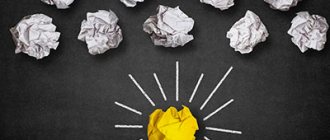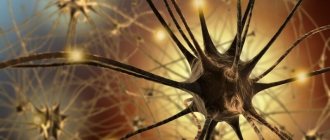What to do if the child is inattentive? How can I help him study better? How can an adult develop memory and imagination?
The human brain is designed in such a way that each hemisphere has its own specialization. In particular, the left hemisphere is responsible for logical and analytical thinking, abilities in languages and mathematics, perception of oral and written speech, memorization of facts, control of the right half of the body. The right hemisphere processes non-verbal information, is responsible for spatial orientation, musical abilities, imagination, creativity, parallel processing of information and control of the left half of the body. Human intelligence is based primarily on the coordinated work of both hemispheres.
Are you preparing your child for school correctly?
If parents take the phrase “after three it’s too late” too literally and enroll a child under 5.5 years old in all the “developmental activities” in a row:
- music,
- English,
- reading,
- account, etc.,
then, as a result, the left hemisphere develops too quickly, to the detriment of the right, and the neural connections between them are weak and few in number. What happens to such a child at school? Although, at first glance, he is more than ready to learn, he has difficulty concentrating on the lesson, writes with errors, and does not perceive the educational material well.
The development of human intelligence directly depends on how closely the left and right hemispheres of the brain are connected. The largest number of nerve connections between them is formed when cross movements are performed regularly, that is, on the left and right sides of the body. It is not for nothing that neuropsychologists recommend starting preparation for school not with the alphabet and copybooks, but with teaching:
- landing when writing;
- gripping a pen or pencil;
- orientation in space;
- as well as the development of large and fine motor skills.
Psychological and pedagogical research confirms: the more a child moves and the better he coordinates his movements, the more his higher mental functions are developed.
Physical exercises to improve blood supply to the brain
Exercises that strengthen the blood vessels of the brain are vital for any modern person: an abundance of stress, sedentary work, poor diet and bad habits can significantly reduce performance and quality of life in general. Exercises with bending and turning the head increase the elasticity of the blood vessels that supply the brain and cause them to expand. All this, together with rhythmic breathing through the nose, increases the flow of oxygen to brain cells and improves mental performance.
When performing exercises for the blood vessels of the brain every day, you need to monitor your breathing and do them without jerks or sharp turns. You should start training in a good mood, when a person is cheerful and full of energy. If circles appear before your eyes, your health worsens, or pain occurs, interrupt the gymnastics and give yourself a few minutes of rest.
On the technique of performing exercises to improve blood circulation, there are the following recommendations:
· When performing exercises to improve cerebral circulation, do not rush anywhere and do not do anything abruptly;
· no matter what complex or technique you choose, it is very important to monitor your breathing: try to breathe evenly and deeply;
· always perform active movements while exhaling, and returning to the starting position while inhaling;
· do not try to perform the maximum number of approaches the first time: the body will end up in another stressful state. Gradually increase the load: each time the muscles will become stronger, and increasing the number of approaches will not be taken seriously;
· listen to your body: if you feel pain or malaise, it is better to postpone the workout or do it in a gentle manner; if the discomfort intensifies, you should consult a doctor.
There are a huge number of exercises to improve blood circulation in the brain. The most effective of them will help to significantly improve your health. When performing a set of exercises designed to directly train the blood vessels of the brain, you should be very careful: dark circles under the eyes indicate excessive tension. In this case, you should rest for a few minutes.
Recommended gymnastics for cerebral vessels:
1. Stand straight and stable with your feet shoulder-width apart. Lower your head as low as possible onto your left shoulder, relax your neck, then lift your head and place it in the same way on your right shoulder. Place your chin as low as possible on your chest, relax your neck, then lift your head and smoothly tilt it back as far as possible. Turn your head as far to the left as possible (your body should remain straight), return to the starting position. Turn your head as far to the right as possible. Repeat 10 times. Perform the exercises smoothly, without rushing.
2. Maintaining a standing position, interlock your fingers and lift them above your head. Imagine that you need to chop wood and make 8-10 blows with an imaginary ax in front of you. With each swing of the “axe”, return to the starting position. Perform movements with effort, but without fanaticism, do not unclench your clasped fingers.
3. Leave your feet shoulder-width apart, stretch your arms in front of you (parallel to the floor). Swing your legs, trying to reach your toes with your toes. Perform the exercise alternately with your left and right legs. Do 8 times for each leg.
4. Lie on your back, grab your lower back with your hands and, as you exhale, slowly begin to raise your legs until they are perpendicular to the floor. With your feet pointing toward the ceiling, inhale and slowly lower your legs. Repeat the exercise 5 times (each time try to increase the number of repetitions).
5. For those who are healthy and physically fit, we suggest the “birch tree” exercise: lying on your back, place your arms bent at the elbows under the natural deflection of the spine and try to push your lower back upward. The legs should be perpendicular to the floor. The task for the person performing this exercise is to hold this pose for as long as possible.
Spend a few minutes a day doing gymnastics to improve blood circulation in the brain, and the results will not keep you waiting: productivity will increase, and many health problems will go away forever.
Exercises for the formation of interhemispheric connections
What to do if time is lost, the child is already in school and his progress leaves much to be desired? Pediatric neuropsychologists advise regularly performing sets of kinesiological (motor) exercises aimed at enhancing the formation and strengthening of neural connections between the hemispheres. They are helping:
- improve thinking and memory;
- make the hemispheres work more harmoniously;
- concentrate attention;
- facilitate the process of reading and writing.
Here are some exercises that both kids and adults are sure to enjoy.
Drawing with two hands
It is better to start the exercise by tracing the contours of simple symmetrical drawings. It is desirable that the image is divided by an axis of symmetry. You can draw with both paints and felt-tip pens, soft pencils. Place the sheet on a table or easel. Take a pencil in each hand and place them at the top point, then begin to move them down along the outline of the drawing. Make sure that the dominant hand does not overtake the subordinate hand. The essence of the exercise is the simultaneity of all actions. Kids can draw with their fingers and palms.
Modeling and origami
Both hands and eyes are involved in folding paper figures and giving salt dough or plasticine a certain shape. This exercise has a positive effect on hand-eye coordination, logical thinking and imagination.
Play with colors
Write down on a piece of paper the names of different colors of the palette with pens with colored paste, felt-tip pens or pencils that do not correspond to them in color, for example, for the word “red” use a blue pencil, and for the word “black” use a yellow pencil. Now, with support on the sheet, say only the names of the colors with which the words are written. Try to do this as quickly as possible. At first the chains should be short: three or four words, then the number of names can be increased.
"Dance"
With your left hand clenched into a fist, with your thumb turned to the side, touch your right little finger. Switch hands. Try to make movements quickly and accurately.
Try on someone else's skin
Sometimes perform habitual actions not with your dominant hand, but with your subordinate hand. For example, if you are right-handed, try stirring tea with your left hand, turning the keys in the lock, or typing a text message.
Simple tips to improve memory
Neurologist of the highest qualification category Sergienko Maria Evgenievna: “Use simple tips to improve your memory” - The brain is something amazing.
Much of his work still remains a mystery. The functioning of individual cells is fairly well explained, but understanding how the brain functions as a whole through the interaction of billions of neurons is only available in a very simplified form and requires further in-depth research. Yes, in the human brain there are about 86 billion neurons that form numerous connections. Our brain remembers everything it passes by, smells, hears, touches, tastes - any information leaves an imprint. The brain is not a sieve, and nothing disappears from it without a trace. Simply put, the brain does not forget the information that we consume, it’s just that if we don’t use it, then it seems to be in the “Postponed” folder and we are not aware of it. In order for us to remember and be aware, the brain needs to form neural connections to this information, and for this the brain must work constantly and hard. The information received influences our thoughts, emotions, and actions in one way or another. Therefore, it is important to read complex literature, listen to good music, not eat anything, and not communicate with people with whom communication does not bring either benefit or joy. The brain is plastic not only in childhood, as previously thought. It has been proven that it forms new neural connections until the end of life. Any work, except boring and routine work, is beneficial for the brain. The key is to deal with constantly changing, complex information. This way we can delay Alzheimer's disease for many years. It is safe to say that our personality is our memory. If you feel that you are having difficulty remembering new information, use simple tips to improve your memory: 1. Use mnemonics. For example, to remember the sequence of colors in the spectrum, we use the phrase “every hunter wants to know where the pheasant sits.” Repetition plays a big role in memorization; neural connections are formed as a result of repetition. 2. Consciously control the memorization process. If a person is introduced to you, say his name to yourself and tell yourself to remember it. 3. Find motivation. Imagine how this information will be useful to you. 4. Refer to associations (Cicero's method). Its essence is that the units of information that need to be remembered are mentally arranged in a familiar room in a certain order. It is enough to remember the room to reproduce the information. 5. Study foreign languages - it develops associative thinking. 6. Remember the phone numbers of people important and close to you, for starters. The main thing is to retain the information for at least a few days. 7. Play cubes. This is how they train the memory and attention of pilots, chess players, and intelligence officers. Several cubes (2-3 to start with) are placed on the table, covered with a hand, then the palm is raised for a few seconds, and then they are covered again and all the numbers on the cubes are called. Gradually the number of cubes can be increased. 8. Follow the “chain”. A person maintains attention on an object as long as it is interesting to him and as long as he finds something new in it. Then attention weakens and switches. The essence of the exercise: imagine some object and keep your thought on it, for example, on a laptop. In a couple of minutes, you will no longer think about the laptop itself, but about the model, manufacturer, etc. (each person builds his own logical chain). The moment you realize that you are no longer thinking about this subject, you need to go back along the chain, remembering each link and, as a result, return to the original subject. The exercise helps in almost any area of knowledge, taking into account any specificity. 9. Examine your consciousness. As you replay the events of the previous day, remember the details and nuances. In this way, you train your ability to keep your attention constantly on and can easily reconstruct a chain of events and remember new information in great detail. 10. Disconnect from problems. Exhaustive work and lack of sleep harm your memory. Organize “free days” for yourself, which are best spent in the fresh air. Attend interesting events and don't forget about exercise. 11. Learn poetry... You can sign up for a consultation with specialists by phone: 211−12−04 Share
How does exercise help relieve stress?
Aerobic exercise (moderate-intensity exercise that uses oxygen for energy) increases your heart rate, causing the body to release endorphins, chemicals that act as a natural pain reliever and improve your mood. After exercise, we experience a natural emotional uplift.
Endorphins not only relieve pain and improve your mood, they also help us sleep better. The combination of these effects can reduce the effects of stress. By exercising regularly, we get the opportunity to enjoy these benefits more often.
Regular exercise (as opposed to one-time exercise) also has a cumulative effect, which manifests itself in improving the level of physical fitness, increasing endurance and losing weight. These are all positive changes, and the fact that we are changing for the better increases our self-esteem. And with the growth of physical strength, emotional strength also increases, and mental well-being improves.
One more thing. During times of stress, it is human nature to concentrate on the problem. Under the weight of worries, it is difficult to think about anything else. And we overwhelm ourselves, feeling that this oppression is increasing. But having inserted physical exercise into our daily schedule, we will be forced to switch. And even a short-term complete redirection of attention to something else can bring vital relief and relieve stress. In addition, coming to the gym can help you find a new circle of communication and additional emotional support.
What is the best time to train?
People who have developed the healthy habit of doing exercises in the morning cannot imagine starting their day without squats, push-ups, bending over or stretching. True, among them there are usually more “larks”, because “night owls” can force themselves to get up a few minutes earlier only by force of will, but evening workouts are much more pleasant for them. Thus, if you are not going to break your routine and your nature, then exercise when it is convenient for you
.
There is also a compromise option: do a small set of dynamic exercises in the morning to help you cheer up, and in the evening take time for stretching, yoga and other exercises that will help relieve the stress of the day and prepare for a relaxing evening.
Neurobics
This training method for our brains was invented by Americans - neuroscientist Lawrence Katz and writer Manning Rubin . And for 15 years now, the world has been studying the book “Fitness for the Mind,” choosing the most suitable of 83 exercises to improve memory and develop intellectual abilities.
To perform fun exercises, you will have to get a little “wonderful”, do daily tasks in a slightly extravagant way, using all 5 senses in an unusual combination. Doing the same routine work makes it difficult for us to focus on new things: memory weakens and concentration falls. But if you do familiar things in an unexpected way, the brain has to build fresh connections between nerve cells and restore them if they have been lost.
Try to develop a craving for everything unusual in every free minute, doing household chores, on the way to work and to the store, sitting in front of the TV or at the computer. Do the exercises cheerfully, ironically, in a good mood - the brain really likes emotions.
What might you need to train at home?
For home workouts you don’t need almost anything except desire, time and a little space, but it is important to understand which exercises to choose for self-training so as not to harm your health and achieve the desired results. As for additional attributes, you shouldn’t rush to a sports store to buy an exercise bike or treadmill; prepare a minimum set
:
- gymnastic mat;
- dumbbells;
- fitness bands.











